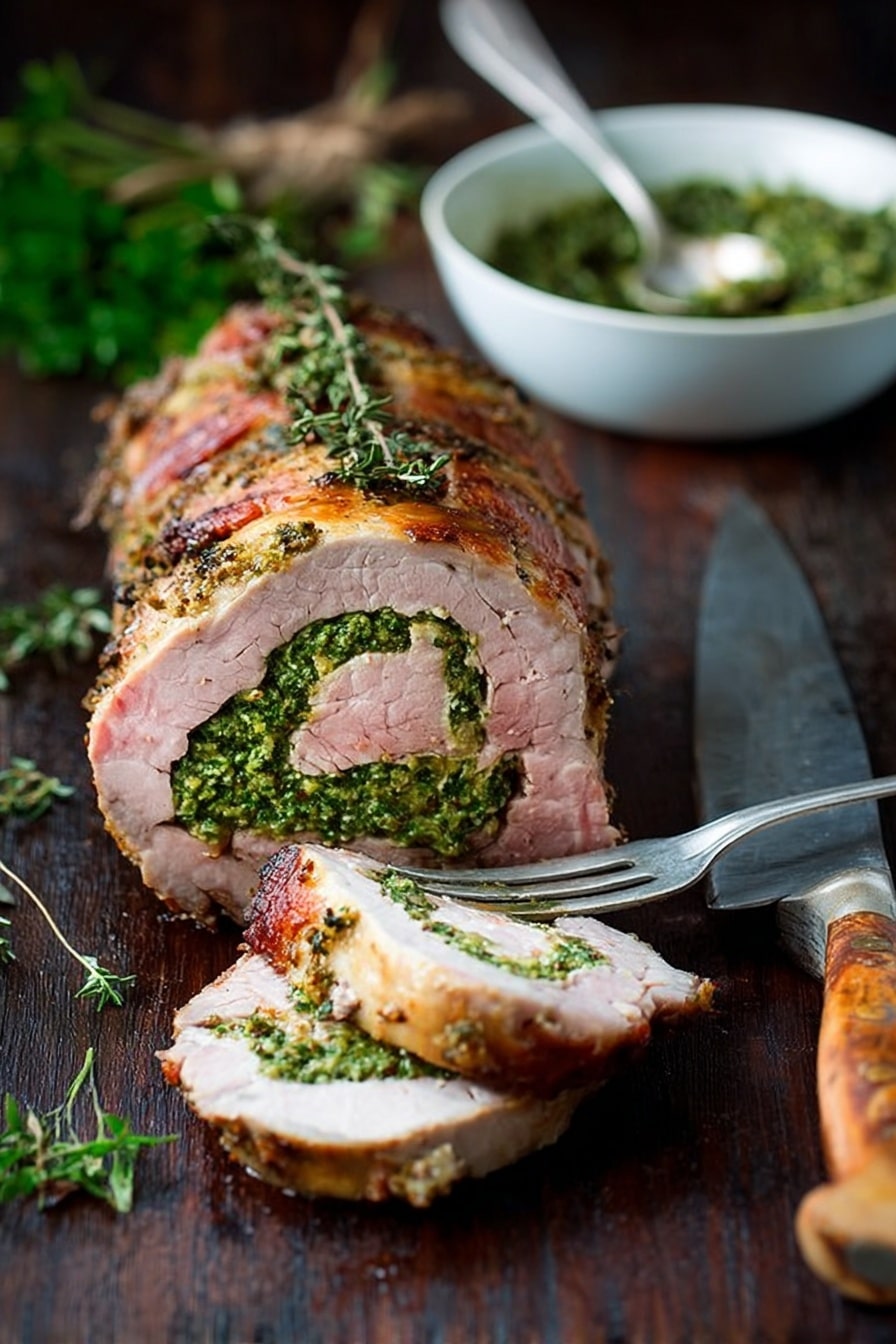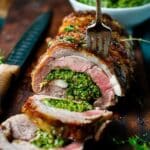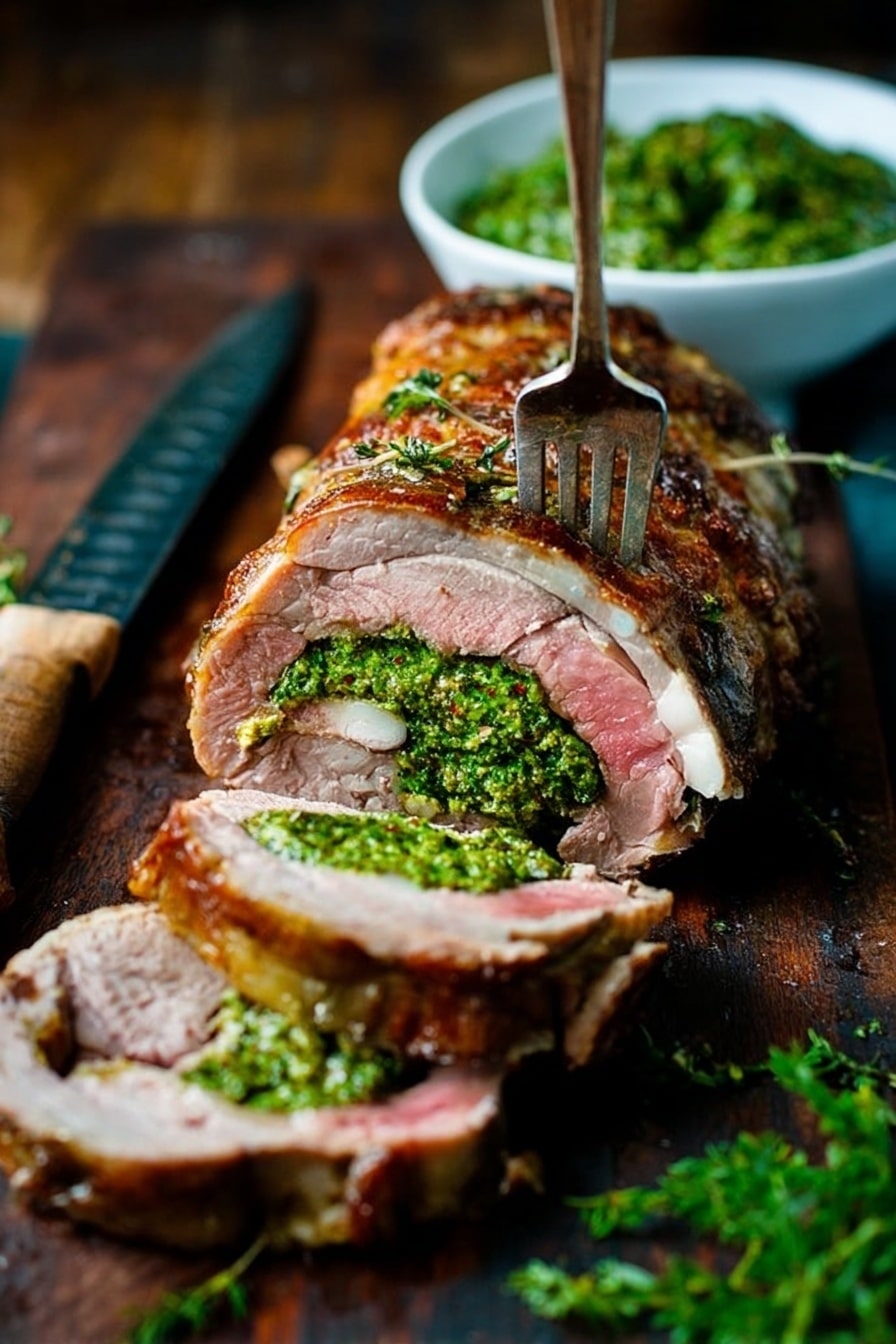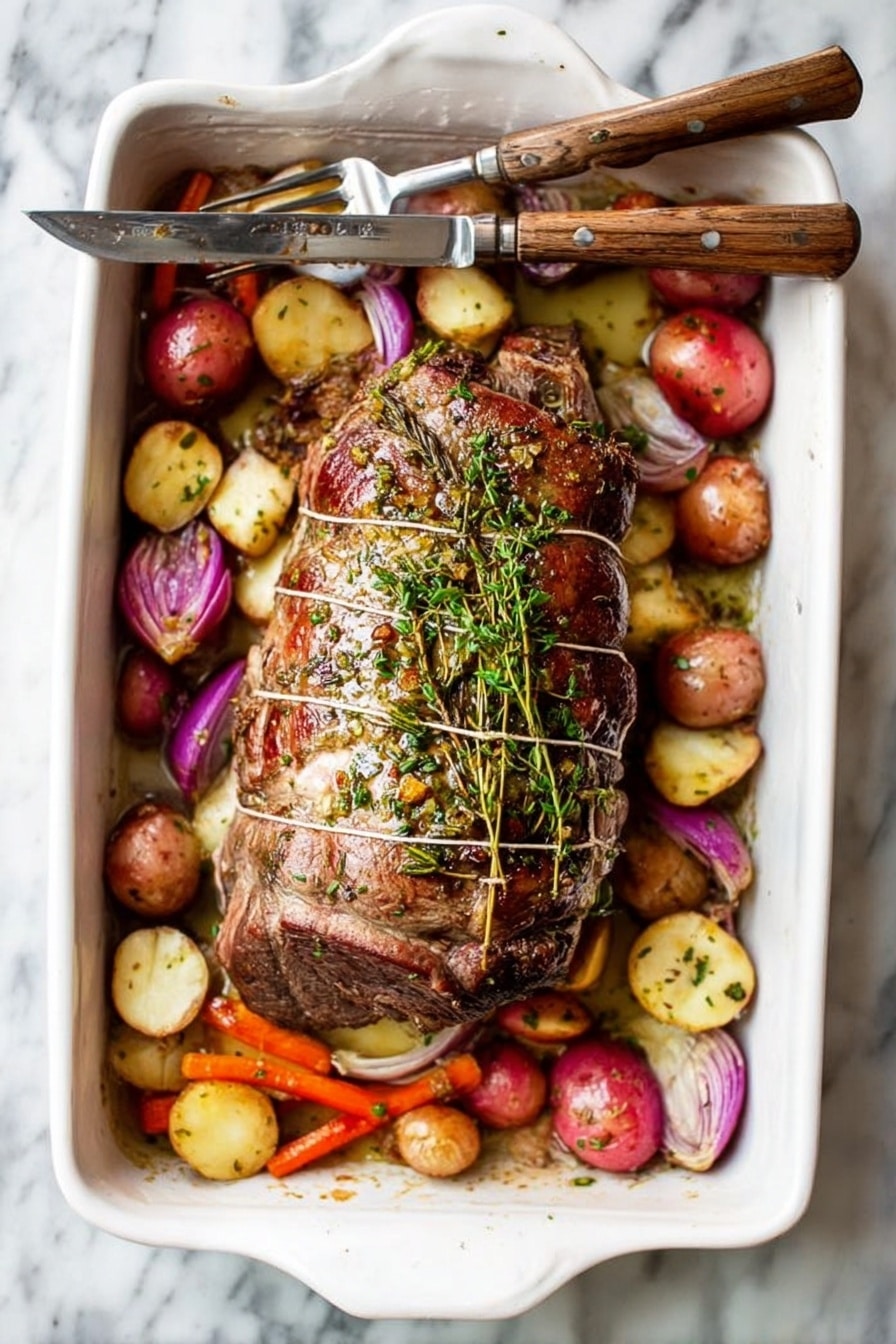If you’re looking for a show-stopping centerpiece that’s both elegant and bursting with flavor, you have to try this Herb Crusted Leg of Lamb Recipe. Believe me, once you experience the juicy, tender lamb wrapped in a fragrant, garlicky herb crust, you’ll want to make it your go-to for special dinners or holiday feasts. I absolutely love how the fresh herbs and garlic create a crust that’s crunchy yet aromatic, making every bite unforgettable. Stick with me—I’ll walk you through the whole process and share some kitchen-tested tricks so you nail it perfectly every time.
Why You’ll Love This Recipe
- A Perfect Herb Blend: The combination of rosemary, thyme, sage, and parsley gives a fresh, savory pop to the lamb that’s irresistible.
- Juicy and Tender: Butterflying the leg of lamb helps it cook evenly so every slice is melt-in-your-mouth tender.
- Customizable Roasting: Whether you want to roast on a rack or over a bed of veggies, this recipe adapts to your style and time.
- Make-Ahead Friendly: You can prep it a day or two ahead, marinate the herb paste overnight, and relax on the day of the cook.
Ingredients You’ll Need
For a dish as flavorful as this, fresh, quality ingredients really shine. I always suggest using fresh herbs and garlic, plus a well-trimmed leg of lamb—the butterflying makes it easier to handle and helps that luscious herb crust get all over. Here’s what you’ll want to grab on your next grocery run.
- Boneless leg of lamb (butterflied): Butterflying makes the roast cook more evenly and provides the perfect canvas for the herb crust.
- Fresh herbs (thyme, sage, rosemary): Pick firm, bright leaves for the crust’s robust flavor—freshness is key here!
- Italian parsley: Adds freshness and a little color contrast to the herb mix—it’s my favorite every time.
- Garlic cloves: Don’t skimp—these give the crust its signature punch.
- Lemon zest: Adds brightness to the herb paste, cutting through the lamb’s richness beautifully.
- Salt and black pepper: Essential for seasoning both inside and out to bring all those flavors together.
- Olive oil: Binds the herb crust and keeps the roast moist—go for a good quality extra virgin if you can.
- Variety of root vegetables: Onions, potatoes, carrots, celery, and more make a savory bed for roasting, soaking up all those incredible lamb juices.
- Mint leaves, parsley, lemon juice, capers, shallot, garlic: These combine into a fresh mint gremolata that perfectly complements the rich lamb.
Variations
I love that this Herb Crusted Leg of Lamb Recipe can be tweaked to your tastes or dietary needs without missing a beat. I often swap some herbs or add other aromatics depending on the season or what’s on hand.
- Herb Substitutions: If you don’t have sage, try oregano or marjoram; they bring a slightly different but lovely flavor dimension.
- Spice it up: Adding a pinch of smoked paprika or chili flakes to the herb crust amps up the flavor for those who love a little kick.
- Vegetarian Accompaniments: Roast a mix of mushrooms, cauliflower, and sweet potatoes instead of root veggies for a different flavor profile with the same roast juices.
- Make it Paleo-friendly: Skip the lemon zest or gremolata dressing if you want to keep it super clean and just enjoy the herb-crusted roast as is.
How to Make Herb Crusted Leg of Lamb Recipe
Step 1: Prep Your Lamb and Herb Paste
First things first—remove your leg of lamb from the packaging and give it a good pat dry. Dry meat always sears and roasts better, so don’t skip this! Trim off any sizable chunks of fat, but I like to leave some marbled fat for extra juiciness. If the outer fat layer is too thick for your liking, feel free to remove some or all of it. If you’re keeping the fat cap, scoring it lightly with a criss-cross knife pattern lets the herb crust really sink in and crisp up.
Next, toss your fresh herbs, garlic cloves, lemon zest, salt, and pepper into a food processor. Pulse until the mixture resembles coarse sand—not too smooth or oily. Then drizzle in the olive oil while pulsing until just combined. This coarse paste will become your herb crust and the flavorful filling inside the lamb.
Step 2: Butterflying and Stuffing the Lamb
Butterflying your lamb means cutting it open like a book and pressing it flat into a rectangle. This makes it easy to spread the herb paste inside evenly. I like to rub two-thirds of the herb paste over the exposed inside, creating a flavorful layer. Then sprinkle the lamb generously with salt and pepper. Roll it back up tightly and tie it with kitchen twine at two-inch intervals—don’t stress about perfect knots; the goal is to keep the filling sealed inside during roasting. After tying, rub the remaining herb paste all over the outside of the lamb for that gorgeous crust.
Step 3: Prepare the Roasting Veggies and Roast
Chop a medley of root vegetables—onions, carrots, potatoes, fennel, parsnips, beets, and leeks work beautifully. Toss them with olive oil, salt, pepper, and a few sprigs of fresh herbs. You have two roasting options: place your lamb on a wire rack over a pan for a quick and even roast, or nestle it on top of your tossed veggies in a large roasting pan to soak up all the lamb’s juices. I’m all about that veggie-bed roasting—it adds a rustic depth and makes your side dish effortless.
Reduce your oven temperature to 325°F (160°C) and roast away! Use a meat thermometer to gauge doneness: medium-rare is around 135°F (57°C), and medium is about 145°F (63°C). Remember, the lamb will continue cooking slightly as it rests.
Step 4: Rest, Slice, and Dress
Once your lamb hits your desired temperature, pull it out and set it on a cutting board, tented loosely with foil. Resting for 15-20 minutes allows the juices to redistribute so every slice is juicy and tender—not dry. During this time, you can let the veggies cook a bit longer if needed—they’ll be perfectly caramelized and infused with lamb flavor by the time you’re ready to serve.
For a fresh pop, mix up the mint gremolata by combining finely chopped mint, Italian parsley, lemon zest and juice, capers, minced garlic, shallot, salt, and pepper. This bright sauce cuts through the richness and adds a burst of herbaceous freshness.
Slice the lamb into thick, juicy pieces, serve with those flavorful roasted veggies, and spoon some gremolata on top. Trust me, your family and guests will rave about it!
Pro Tips for Making Herb Crusted Leg of Lamb Recipe
- Don’t Skip Butterflying: This trick makes the roast cook faster and more evenly, plus gives a bigger surface for that delicious herb crust.
- Use a Meat Thermometer: Relying on temperature is the most foolproof way to avoid under or overcooking your lamb.
- Rest Your Roast: I can’t stress this enough—letting the lamb rest seals in the juices for the best texture.
- Don’t Overdo the Oil in Herb Paste: Keep the herb crust on the drier side so it crisps beautifully without steaming during roasting.
How to Serve Herb Crusted Leg of Lamb Recipe

Garnishes
I adore serving this lamb with a sprinkle of fresh mint or additional chopped parsley straight from the gremolata to brighten the plate. Sometimes I add a few lemon wedges on the side for guests who want an extra burst of citrus—it really lifts the richness beautifully.
Side Dishes
Roasted root vegetables cooked with the lamb should be your first choice—they soak up all the lamb’s savory juices and are the ultimate comfort food side. If you want to add something green and fresh, steamed asparagus or a simple arugula salad dressed with lemon vinaigrette complements the flavors wonderfully.
Creative Ways to Present
For dinners where I want to impress, I serve the sliced lamb fanned out on a rustic wooden board surrounded by the roasted veggies, sprinkled with gremolata and garnished with small sprigs of rosemary or thyme. It makes such a stunning, inviting centerpiece that instantly feels festive and special.
Make Ahead and Storage
Storing Leftovers
Leftover lamb freezes and stores really well. I slice it first, then pack portions into airtight containers or freezer bags with some of the roasted veggies. In my experience, refrigerated leftovers taste best within 3-4 days—just keep them well covered to avoid drying out.
Freezing
I’ve frozen this lamb plenty of times and find that wrapping sliced portions tightly in plastic wrap and then foil locks in moisture for up to 3 months. When thawing, do it overnight in the fridge for the best texture.
Reheating
To reheat, I use a low oven (around 300°F) and cover the lamb loosely with foil to keep it moist. About 15-20 minutes usually does the trick for warmed-through slices without overcooking. Alternatively, a quick pan sauté over medium heat with a splash of broth or olive oil helps retain juiciness.
FAQs
-
Can I use a bone-in leg of lamb for this herb crust recipe?
Absolutely! While boneless makes it easier to butterfly and roll, bone-in works perfectly too. The cooking time might be a bit longer, so I recommend using a meat thermometer to check doneness and accounting for the bone’s presence which can affect heat distribution.
-
How do I know when the lamb is cooked perfectly?
The most reliable way is using an instant-read meat thermometer. For medium-rare, target around 135°F (57°C), and for medium, 145°F (63°C). Remember to let the lamb rest—its temperature can climb a few degrees after removing from the oven which results in perfect doneness.
-
Can I prepare the herb crust paste ahead of time?
Yes! You can make the herb paste up to 2 days ahead and keep it refrigerated. This actually helps the flavors meld better. Just bring it to room temperature before spreading it on the lamb for easier application.
-
What’s the best way to butterfly a leg of lamb?
Place your boneless leg of lamb fat-side down and carefully slice horizontally along the thicker edge without cutting all the way through. Open it like a book, then press flat. You can ask your butcher to do this for you too if you want to skip the knife work.
-
What vegetables work best for roasting with the lamb?
Root vegetables like carrots, potatoes, parsnips, fennel, beets, and onions are fantastic because they absorb the lamb’s juices as they roast, becoming tender and flavorful. Feel free to mix and match based on what you enjoy or have on hand!
Final Thoughts
I can’t tell you how many times this Herb Crusted Leg of Lamb Recipe has wowed my family and friends. It makes any occasion feel special without being intimidating to tackle in your kitchen. The flavors are vibrant, the meat is tender, and the roasted veggies soak up every bit of juiciness. I hope you give it a try—you’ll be rewarded with a stunning dish and plenty of compliments at the table. Enjoy every bite of this classic that’s become a favorite in my home, and I’m sure will be in yours too.
Print
Herb Crusted Leg of Lamb Recipe
- Prep Time: 45 minutes
- Cook Time: 3 hours 30 minutes
- Total Time: 4 hours 15 minutes
- Yield: 8 servings 1x
- Category: Main Course
- Method: Roasting
- Cuisine: Mediterranean
Description
This Herb Crusted Leg of Lamb is a succulent and flavorful roast perfect for special occasions like Easter or Christmas. The boneless leg of lamb is butterflied, stuffed with a fragrant garlic and herb paste, and roasted to perfection, either alone on a wire rack or resting on a bed of seasoned root vegetables. Finished with an optional fresh mint gremolata, this recipe delivers a tender, aromatic centerpiece with a crisp herb crust and delicious roasted veggies.
Ingredients
Lamb and Herb Crust
- 4–6 lb boneless leg of lamb, preferably butterflied
- Salt and black pepper to taste
- 1 cup fresh herbs, packed (mix of 2 or 3 of thyme, sage, rosemary)
- 1 cup Italian parsley, packed (about ½ bunch, tender stems okay)
- 15–20 cloves garlic
- 1 tablespoon lemon zest
- ½ tsp salt per pound of lamb
- 5 tablespoons olive oil
Roasting Vegetables
- 6–8 cups chopped root vegetables (onions, potatoes, carrots, celery, fennel bulb, parsnips, beets, sunchokes, leeks, whole garlic cloves)
- Olive oil to coat vegetables
- Salt and pepper to taste
Mint Gremolata (optional)
- ¼ cup olive oil
- ⅓ cup finely chopped mint leaves, packed
- ⅓ cup finely chopped Italian parsley
- 1 tablespoon lemon zest
- 1 tablespoon lemon juice
- 1 tablespoon chopped capers
- 1 finely minced garlic clove
- 2 tablespoons finely chopped onion or shallot
- Salt and pepper to taste
Instructions
- Prepare the Lamb: Remove the leg of lamb from packaging and pat dry thoroughly. Trim away large chunks of unwanted fat, leaving some marbled fat for flavor. If keeping the outer fat layer, score it in a diagonal crosshatch at about 1-inch intervals just through the fat. Place the fat side down. If needed, butterfly the lamb to form a rectangle for stuffing.
- Make the Herb Paste: In a food processor, combine fresh herbs, garlic cloves, salt, pepper, and lemon zest. Pulse until the mixture resembles coarse sand. Add olive oil and pulse briefly until combined into a dry, coarse paste—not too smooth or oily.
- Season and Stuff the Lamb: Sprinkle all sides of the lamb with salt and pepper. Spread two-thirds of the herb paste evenly over the inside surface of the butterflied lamb. Fold or roll the lamb and tie securely at 2-inch intervals with kitchen twine. Rub the remaining herb paste over the outside of the tied lamb. At this point, you may refrigerate the lamb for 1 to 3 days, bringing it to room temperature at least one hour before roasting.
- Prepare Roasting Vegetables: Chop a variety of root vegetables into bite-size pieces. Toss them with olive oil, salt, pepper, and a few sprigs of herbs. Spread evenly in a large roasting pan, forming a bed for the lamb.
- Roast the Lamb: Place the herb-crusted lamb on top of the bed of vegetables (or on a wire rack over a pan if you prefer). Preheat the oven to 325°F (163°C). Roast the lamb until it reaches the desired doneness based on weight: generally about 15-20 minutes per pound for medium rare. Use a meat thermometer to check internal temperature (130-135°F for medium rare). Remove the lamb from the oven and transfer it to a cutting board, loosely cover with foil, and let it rest for 15-20 minutes. Meanwhile, continue roasting the vegetables if needed until tender.
- Make the Mint Gremolata (optional): In a small bowl, combine olive oil, chopped mint, parsley, lemon zest, lemon juice, capers, minced garlic, finely chopped onion or shallot, salt, and pepper. Stir well to create a fresh, vibrant sauce.
- Serve: Slice the rested lamb and serve alongside the roasted root vegetables, drizzled or topped with the optional mint gremolata for a fresh herbal punch.
Notes
- This herb-crusted leg of lamb is ideal for festive occasions such as Christmas dinner or Easter brunch.
- Butterflying the lamb creates a perfect surface area for the herb paste and stuffing.
- Resting the lamb after roasting is essential to redistribute juices for tender slices.
- Roasting over vegetables imparts additional flavor and creates a delicious side dish.
- The optional mint gremolata adds freshness and brightness to the rich lamb.
Nutrition
- Serving Size: 6 ounces (without vegetables)
- Calories: 407
- Sugar: 0.2 g
- Sodium: 515 mg
- Fat: 22.9 g
- Saturated Fat: 5.5 g
- Unsaturated Fat: approximately 17.4 g
- Trans Fat: 0 g
- Carbohydrates: 1.9 g
- Fiber: 0.4 g
- Protein: 47.1 g
- Cholesterol: 145.2 mg



